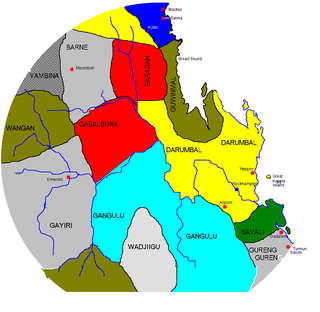The Wandandian are an Aboriginal Australian people of the South Coast of New South Wales with connections to the Yuin and Tharawal nations.
The Jupagalk or Jupagulk are an Aboriginal people of northern Victoria, Australia. They may have been a Wergaia clan.
The Tulua people were an Aboriginal Australian people of Queensland, in the southern to central region from the coast to the ranges. The Dappil and Tulua people possibly spoke the same language.
The Goeng or Gureng were an Aboriginal Australian people of the state of Queensland. They lived in the area of the area of present-day Gladstone.

The Koinmerburra people, also known as Koinjmal, Guwinmal, Kungmal and other variants, are an Aboriginal Australian people of the state of Queensland. They are the traditional owners of an area which includes part of the Great Barrier Reef.
The Kuungkari are an indigenous Australian people of Queensland. They are to be distinguished from the Kunggari.
The Ngameni are an indigenous Australian people of South Australia who once spoke the Ngameni language.
The Yawarrawarrka were an in Indigenous people of South Australia.
The Wanggumara, also spelt Wangkumara, Wongkumara, Wangkumarra, and other variants, are an Aboriginal people of the state of Queensland, Australia.
The Punthamara were an indigenous Australian people of the state of Queensland.
The Wakara or Wakura were an indigenous Australian people of the state of Queensland.
The Maikathari (Mayi-Thakurti) were an Aboriginal Australian people of the state of Queensland.
The Maijabi (Mayi-Yapi) were an indigenous Australian people of the state of Queensland.
The Kunandaburi or Karendala (Garandala) were an indigenous Australian people of the state of Queensland.
The Kunggara, also known as Kuritjara, are an indigenous Australian people of the southern Cape York Peninsula in Queensland.
The Mingin, also known as the Mingginda, are an Aboriginal Australian people of the state of Queensland, who lived in the Gulf Country east of Moonlight Creek and the Yukulta / Ganggalidda people in the southern Gulf of Carpentaria.
The Kokomini (Gugumini) are reported to have been an indigenous Australian people of the state of Queensland, though some indications suggest the term may refer to a loose confederation of tribal groups.
The Gawambaraay (Kawambarai) are an Aboriginal Australian people of the state of New South Wales, closely connected to the Gamilaraay (Kamilaroi) people. Their traditional lands are in the central–western district of New South Wales
The Wanjiwalku were an indigenous Australian people of the state of New South Wales.
The Paaruntyi are an indigenous Australian people of the state of New South Wales. They are not to be confused with the Parrintyi.